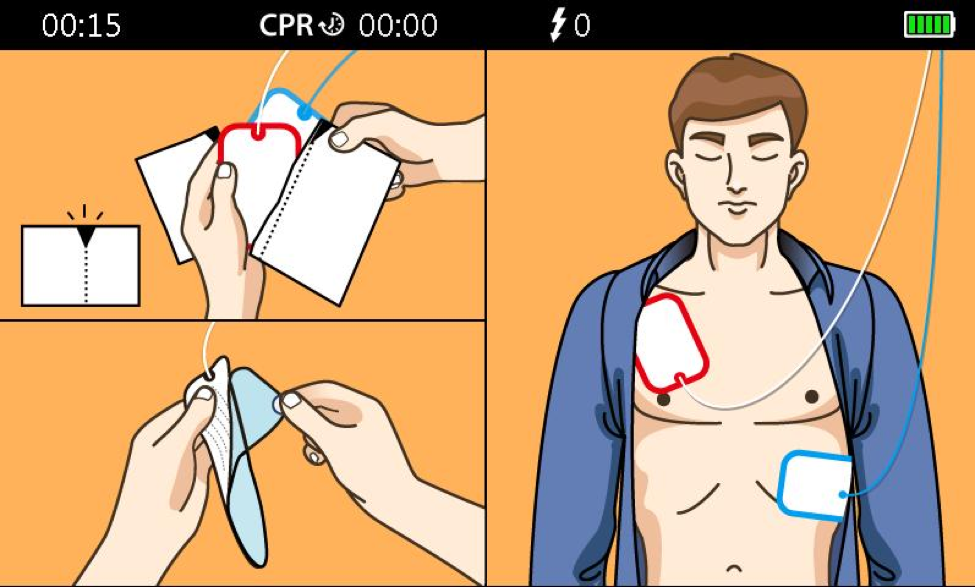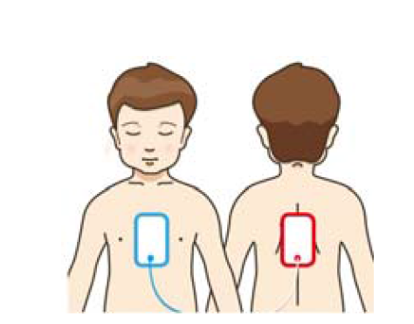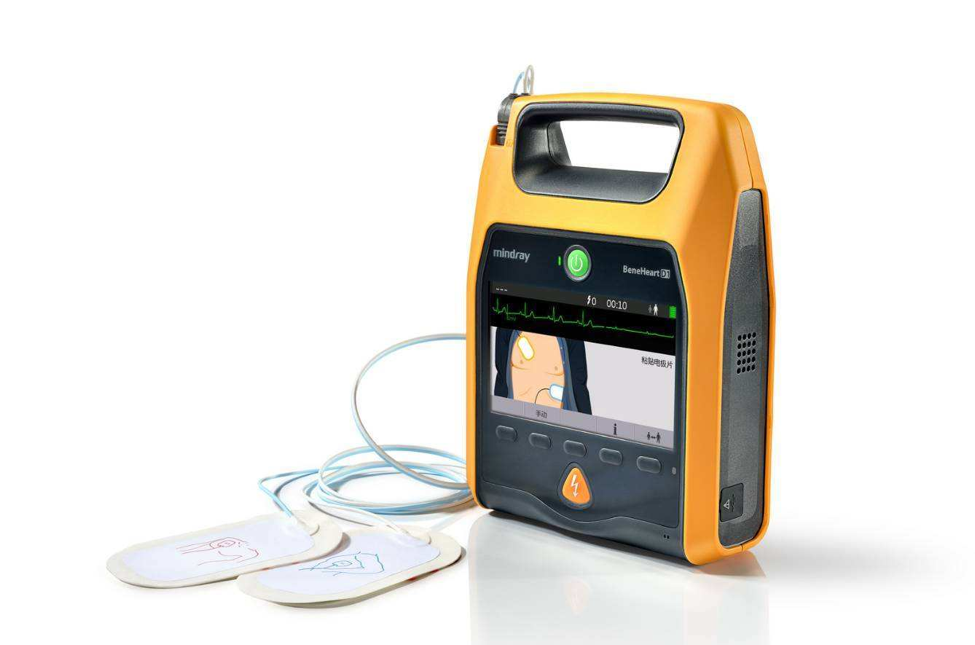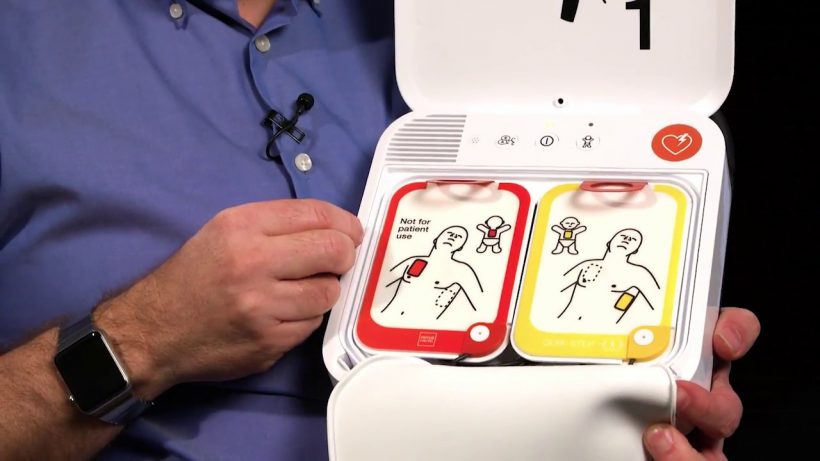A large sum of cardiac arrests occurs in public spaces. Studies have discovered that using an automated external defibrillator (AED) can significantly reduce their fatality [1]. This device delivers an electric shock to relieve ventricular defibrillation and revive the cardiac arrest patient. While performing cardiopulmonary resuscitation (CPR) on the patient, using an AED is very critical.
Every minute wasted before using the defibrillator drops the patient’s survival rate by an average of 7% to 10%. By contrast, the immediate use of an AED has been proven to increase survival rates by 41 – 74% [2].
1. Placement of AED Pads
- When the victims collapse, bring the body to a safe, dry space. Remove any clothing from the victim’s body to place the pads.
- Turn on the AED machine.
- Peel the adhesive packaging. Place one AED pad under the collarbone on the upper-right chest. Place the second AED pad near the left armpit on the patient’s lower ribcage.
- Start the defibrillation process and wait for the patient to revive. If the patient’s pulse doesn’t return, the AED will advise a second shock. In some cases, the AED device with the capability of providing high energies, such as the BeneHeart C Series AED, will advise a higher subsequent shock to increase the chance of successful defibrillation. This is because 360J energy is recommended to improve the termination rate of refibrillation when 200J failed, according to 2015 AHA Guidelines for CPR and ECC and ERC Guidelines for Resuscitation 2015.

2. Use of AED Pads on Women and Children
Many people ask how to use an AED on women and children. If the patient is a woman, you must remove the bra and place the pads, as we have described above.
If it’s a child below eight years of age or anyone below 25kg, you may find it challenging to place the AED pads. You should use pediatric pads to treat child victims. But if they’re not available, it is equally recommended to use pediatric/adult 2-in-1 pads. Both types of pads are available with Mindray BeneHeart AEDs. When applying the pads, make sure that they do not touch each other, and place one pad on the center of the chest and one on the back.

Start the machine and let it send shocks to the unconscious body. Make sure you don’t touch the body while the machine is sending shocks to the body. Continue CPR and AED treatment until the child regains consciousness or until medical help arrives.
If you have a child with heart disease, you can try online AED training programs provided by the Red Cross or some renowned health organizations.
3. Ways to Stick with Metal Accessories
It’s possible that when using an AED, you may find that the patient has some metal device attached internally [4]. These implantations, such as a pacemaker or an implantable defibrillator, are used to regulate and assist the patient’s heartbeat. An internal pacemaker is usually placed near the heart in the upper area of the chest. The defibrillator is a bit larger than a pacemaker and is placed in the abdominal area.
These devices don’t occupy too much space inside the chest, so it’s easy to avoid placing AED pads over them. You should not stick AED pads above these metal installations under any circumstances. If it’s difficult to use the AED machine without coinciding with metal accessories, it’s best to get professional help.

4. Replacement of AED Pads
AED pads use water-based electrolytic gel to carry the electric shocks to the patient’s body. The pads are attached via wires to electrodes in the AED machine. These pads are disposable, so you should replace them once they reach the expiration date. When this electrolyte begins to dry out, the AED will chirp to give you a signal. AED pads can typically last up to two year or three, but some AEDs in the market come with pads of longer life expectancy (up to 5 year for the BeneHeart C Series AED pads and batteries) to reduce maintenance cost. However, even when your AED pads have longer lifespan, it’s best to purchase and keep extra pads near the device, so that you can change it when needed. The specific type of AED replacement pads you can use depend on the brand and model of your device.
When you replace your AED pads, make sure to check the battery life of your AED device as well. It’s also a good idea to keep a record of the times you purchase new pads and batteries and discard old ones.
When someone gets a heart attack in public, there’s nothing better than having and effective AED with a set of workable accessories at hand.
References
[1] Siobhan Gilchrist, M. (2020). A Summary of Public Access Defibrillation Laws, United States,2010. [online] PubMed Central (PMC). Available at: https://www.ncbi.nlm.nih.gov/pmc/articles/PMC3372977/ (Accessed: 30 January 2020) [2] Sports Health. (2009). Available at:https://www.ncbi.nlm.nih.gov/pmc/articles/PMC3445113/ (Accessed: 30 January 2020) [3] CPR / AED Study Guide: Part 2 – National CPR Association. (2020). Available at:https://www.nationalcprassociation.com/cpr-aed-study-guide-part-2/ (Accessed: 30 January 2020) [4] AEDs – Special Circumstances | ACLS.com. (2020). Available at:https://acls.com/free-resources/knowledge-base/bls-articles/aeds-special-circumstances (Accessed: 30 January 2020)Laila Azzahra is a professional writer and blogger that loves to write about technology, business, entertainment, science, and health.
